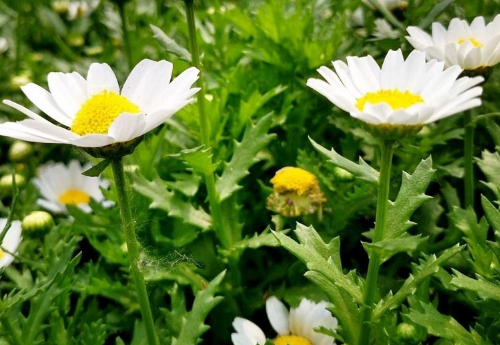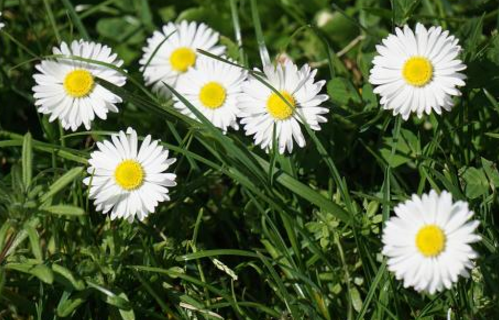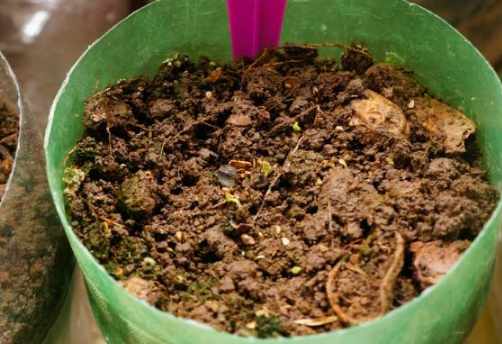Propagation methods of daisies
1. seed propagation
The south is generally sown in August-September, while the north is mostly sown in spring. Generally, seeds are evenly spread, covered with fine soil, and then watered, maintaining the temperature at about 28 ° C, and new buds can germinate in about 10 days.

2. Plant division propagation
Generally, in the middle and late March, the old chrysanthemum vegetables can be dug out to expose the root neck, and the lateral buds with root systems can be cut off together with the old roots and transplanted into the new pots. Ramite propagation can also be carried out when new shoots germinate.
3. cutting propagation
Cuttage propagation is generally in April-June, it is best to use new soil to add decomposed organic fertilizer to do a good seedbed. Cut branches with 3-5 nodes, 8-10 cm long, remove basal leaves, and bury them to half the length of the cuttings. Keep the soil moist and ventilated after cutting.
How to breed daisies
Daisy breeding methods Daisy often autumn sowing for 2 years of cultivation, and cold areas for annual cultivation of spring sowing. In mid-August or early September, seeds are sown and propagated in open seedbeds. After sowing, it is advisable to shade with reed curtains and not to cover them with film. When the seedlings are ready, remove the curtain. When two or three leaves grow, they are planted for the first time, with bare roots and no soil. When the seedlings produce 3 ~ 4 true leaves, transplant them twice with soil lumps, which can promote the lateral roots of big turtle. Prevent excess growth. Daisy winter cold tolerance, fear severe frost and air drying. The thickness and cover time of cattail mat should be controlled flexibly according to the growth of flower seedlings and cold weather to prevent excessive growth and effectively control flowering period. After one or two transplants in autumn, the flower altar can be directly planted when it blooms in spring. After autumn seedling division without reverse bed transplant, spring should be added enough base fertilizer in the bed after maintenance molding, into the flower altar planting or out of the nursery market. When planting, apply decayed leaf manure or manure as base manure, plant spacing 15 cm. After planting, it is advisable to water once every 7 ~ 10 days. Apply thin fecal water every 2 to 3 weeks until flowering.
Daisy growth period like sunshine, not tolerant shade. After autumn sowing of daisies, if there is no seedling transplantation, the seedlings can be raised at the end of October, separated, the root clusters slightly with a little soil, and then grab a handful of moist fertile soil prepared in advance with more humus and slightly sticky soil. Put one or two seedlings in the center of loam tightly into clumps, store them in Yang beds in turn, spray moisture, promote the growth of fibrous roots, plant small and healthy, and directly plant flower beds or sell them on the market in spring.
> View and apply
Wei chrysanthemum seedlings in autumn and winter, small plants, green and lovely, in spring bloom, for the rare season chrysanthemum flowers, but also feel fresh. Usually planted in flower beds or potted plants, balcony, walkway and other places to watch. Daisy leaves for spoon-shaped clusters were rosette, dense dwarf, green color. From the leaves out of flower scape, a scape a flower, staggered arrangement, appearance simple, delicate flowers, color harmony.
If you can watch carefully, spherical head, the central cluster of yellow tubular flowers, surrounded by colorful tongue flowers, commonly known as petals. The colors are white, reddish, crimson, etc., and a cluster of tongue-shaped leaves match, forming a small pattern. Early spring flowering, full of vitality, with a gentleman's demeanor and innocent style, won the Italian love, and it will be designated as the national flower. Daisy flower language: forever happy.
How daisies breed, how daisies breed
Daisies bloom in early spring, full of vitality, with a gentleman's demeanor and innocent style, won the Italian love, and thus elected as the national flower. So how do daisies reproduce? The following is an introduction to the daisy breeding method.
How daisies breed, how daisies breed
Daisy can be divided into plants, cuttings, grafting, seeding and other methods. Grafting method and seeding method, technical requirements are high, the propagation process is more complicated, without superb cutting, grafting skills and improved seed selection, artificial pollination and other technologies, it is difficult to reproduce successfully. These two propagation methods, but also only when a large number of seedlings are needed, in the nursery, family chrysanthemum, generally using the sub-plant method and cuttage method to propagate.
seed propagation
South more in autumn August-September sowing, but also spring sowing, but often poor summer growth. North more in spring sowing, can also be autumn sowing, but in winter flower seedlings need to be moved into the greenhouse for cultivation management. Because daisy seeds are relatively small, they are usually scattered. But the seedlings often cannot maintain the characteristics of the mother plant. Before sowing, apply enough decomposed organic fertilizer as base fertilizer, and deeply turn fine harrow to make flat bed. Mix seeds with fine sand and sow them. Cover with fine soil about 0.5 cm thick. Cover with sunshade net and irrigate thoroughly after sowing.
After sowing, keep the temperature at about 28℃. Cover with plastic film in early spring when it is cold and rainy to keep soil moisture and temperature. Water should be sprayed carefully to prevent soil surface hardening. After about 10 days, the seedlings emerge, remove the sunshade net or plastic film, and transplant to the field when the seedlings have 2-3 pieces. Chrysanthemum vegetables can be sown in February in southern China and in early April in cold northern regions, with a seed rate of about 0.2 kg per mu.
division propagation
Because of the great variation of seedlings, some excellent varieties can be propagated by dividing plants, but their growth potential is not as good as that of seedlings, and their fruit setting is poor. In the middle and late March, the old chrysanthemum vegetables can be dug out to expose the root neck, and the lateral buds of the existing root system together with the old roots can be cut off and transplanted into the field. It is suitable for ramet propagation to germinate new shoots.
cutting propagation
Cuttage propagation can be carried out in the whole growing season, and the survival rate of cuttage is the highest from April to June. Seedbed had better use new soil mixed with the organic fertilizer that composted classics piles. Cut the branches with 3-5 nodes and 8-10 cm long, remove the basal leaves, and bury them to 1/3-1/2 of the cutting length. After cuttage, keep the work bed moist, avoid waterlogging, shade in high temperature season, and keep warm and moist in plastic film arch shed when the temperature is low. Generally, it can be transplanted to the field after 15 days.
- Prev

How to breed daisies
1. Light daisies like sunshine, but also tolerant of semi-shade, especially in flowering, sufficient sunshine will make the flowers open more brightly, but pay attention to avoid strong light in summer. 2. Water Daisy in the bud period of water demand is very large, to the right amount of water, is the soil moist
- Next

Planting methods of Daisy Seeds
1. Before sowing the treated seeds, soak the daisy seeds for one night so that the seeds can fully absorb water and promote germination. two。 In order to raise seedlings in basin soil, it is best to cultivate seedlings in the seedling basin before transplanting. There is not much demand for the soil, just keep it warm and moist.
Related
- Fuxing push coffee new agricultural production and marketing class: lack of small-scale processing plants
- Jujube rice field leisure farm deep ploughing Yilan for five years to create a space for organic food and play
- Nongyu Farm-A trial of organic papaya for brave women with advanced technology
- Four points for attention in the prevention and control of diseases and insect pests of edible fungi
- How to add nutrient solution to Edible Fungi
- Is there any good way to control edible fungus mites?
- Open Inoculation Technology of Edible Fungi
- Is there any clever way to use fertilizer for edible fungus in winter?
- What agents are used to kill the pathogens of edible fungi in the mushroom shed?
- Rapid drying of Edible Fungi

